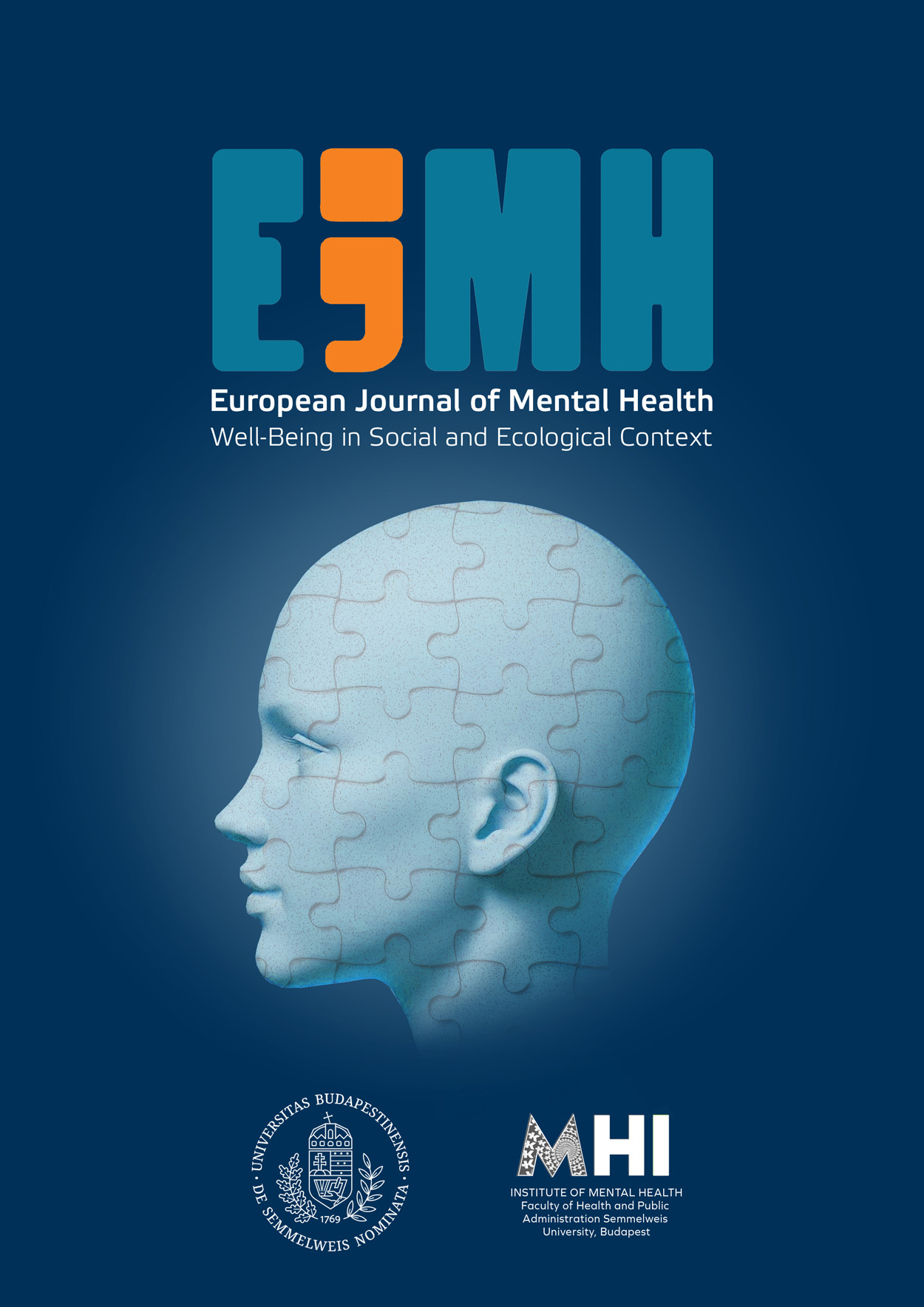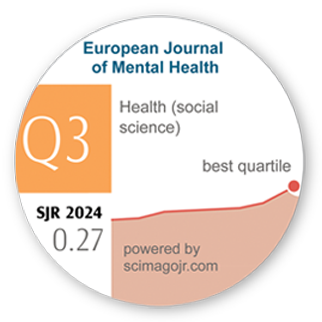Dual Personality Model: Adjustment Indexes Towards an Integrative View of Personality Traits in a Highly-educated Argentinian Sample
DOI:
https://doi.org/10.5708/EJMH.18.2023.0009Keywords:
personality, pathological traits, positive traits, integrated model, dual personality modelAbstract
Introduction: Differentiating between normal, pathological, and positive traits may be achieved by conceptualizing personality traits as a continuum in which these aspects could be placed as sickness or health poles. The tendency to focus on one aspect of the continuum to the detriment of the other has prompted the following question: What would be the outcome of studying both aspects conjointly?
Aims: This study aimed at assessing the appropriateness of different personality adjustment indexes proposed by the Dual Personality Model. These indexes combine positive and pathological aspects of personality in a single measure.
Methods: The sample was composed of 1061 individuals from the general Argentinian population (Mage=39.87, SD=14.68, 51% males).
Results: Individuals who scored higher on the personality adjustment index (PAI) had higher positive traits and well-being, and lower pathological traits, psychological symptoms, and lack of personality functioning. Also, higher scores on each trait continuum index were related to favorable outcomes.
Conclusions: It was concluded that PAI and trait continuum indexes are potentially useful measures for psychological research and for applied fields. The possibility of combining pathological and healthy aspects in a single measure makes it possible to view individuals in an integrated manner in any personality assessment. The indexes should be considered global measures which could be further complemented with a disaggregated analysis.
References
Allport, G.W. (1927). Concepts of trait and personality. Psychological Bulletin, 24, 284–293.
https://doi.org/10.1037/h0073629
Allport, G.W. (1937). Personality: A Psychological Interpretation. Holt Rinehart & Winston.
American Psychiatric Association (2013). Diagnostic and statistical manual of mental disorders, Fifth Edition. American Psychiatric Publishing.
https://doi.org/10.1176/appi.books.9780890425596
American Psychiatric Association (2022). Diagnostic and statistical manual of mental disorders, Fifth Edition, Text Revision. American Psychiatric Publishing.
https://doi.org/10.1176/appi.books.9780890425787
Antaramian, S. (2015). Assessing psychological symptoms and well-being: Application of a dual-factor mental health model to understand college student performance. Journal of Psychoeducational Assessment, 33(5), 419–429.
https://doi.org/10.1177/0734282914557727
Antaramian, S. P., Huebner, E. S., Hills, K. J., & Valois, R. F. (2010). A dual-factor model of mental health: Toward a more comprehensive understanding of youth functioning. The American Journal of Orthopsychiatry, 80(4), 462–472.
https://doi.org/10.1111/j.1939-0025.2010.01049.x
Bach, B., Sellbom, M., & Simonsen, E. (2018). Personality Inventory for DSM-5 (PID-5) in clinical versus nonclinical individuals: Generalizability of psychometric features. Assessment, 25(7), 815–825.
https://doi.org/10.1177/1073191117709070
Buecker, S., Maes, M., Denissen, J. J. A., & Luhmann, M. (2020). Loneliness and the Big Five Personality Traits: A Meta‐analysis. European Journal of Personality, 34(1), 8–28.
https://doi.org/10.1002/per.2229
Cattell, R. B. (1965). The Scientific Analysis of Personality. Penguin.
Clark, L. A., Livesley, W. J., & Morey, L. (1997). Personality disorder assessment: The challenge of construct validity. Journal of Personality Disorders, 11, 205–231.
https://doi.org/10.1521/pedi.1997.11.3.205
Cloninger, C. R. (2000). A practical way to diagnosis personality disorders: a proposal. Journal of Personality Disorders, 14(2), 99–108.
https://doi.org/10.1521/pedi.2000.14.2.99
Costa, P. T. & McCrae, R. R. (1985). The NEO Personality Inventory Manual. Psychological Assessment Resources.
https://doi.org/10.1037/t07564-000
de la Iglesia, G. & Castro Solano, A. (2018). The Positive Personality Model (PPM): Exploring a new conceptual framework for personality assessment. Frontiers in Psychology, 9, Article 2028.
https://doi.org/10.3389/fpsyg.2018.02027
de la Iglesia, G. & Castro Solano, A. (2019a). Academic achievement of college students: The role of the Positive Personality Model. Problems of Education in the 21st Century, 77(5), 572–583.
http://dx.doi.org/10.33225/pec/19.77.572
de la Iglesia, G. & Castro Solano, A. (2019b). Positive Personality Model: Which traits relate to complete mental health as conceived by the Dual Factor Model? Psychological Thought, 12(2), 202–213.
https://doi.org/10.5964/psyct.v12i2.377
de la Iglesia, G. & Castro Solano, A. (2021). ICCP: Inventario de los Cinco Continuos de la Personalidad. Evaluación de los rasgos positivos y patológicos de la personalidad. [FCPI: Five Continua Personality Inventory. Assessment of positive and pathological personality traits]. Paidós.
de la Iglesia, G., Lupano Perugini, M. L., & Castro Solano, A. (2019). Modelo de Personalidad Positiva: su asociación al funcionamiento óptimo en trabajadores activos [Positive Personality Model: Its relation to optimal functioning in active workers]. Revista de Psicología, 37(2), 425–449.
https://doi.org/10.18800/psico.201902.003
Deary, I. J. (2009). The trait approach to personality. In P. J. Corr & G. Matthews (Eds.), The Cambridge Handbook of Personality Psychology (pp. 89–109). Cambridge University Press.
https://doi.org/10.1017/CBO9780511596544.009
DeYoung, C.G., & Allen, T.A. (2019). Personality neuroscience: A developmental perspective. In D. P. McAdams, R. L. Shiner, & J. L. Tackett (Eds.), Handbook of personality development (p. 79–105). The Guilford Press.
Eklund, K., Dowdy, E., Jones, C., & Furlong, M. (2010). Applicability of the Dual-Factor Model of mental health for college students. Journal of College Student Psychotherapy, 25(1), 79–92.
https://doi.org/10.1080/87568225.2011.532677
Emilsson, M., Gustafsson, P., Öhnström, G., & Marteinsdottir, I. (2020). Impact of personality on adherence to and beliefs about ADHD medication, and perceptions of ADHD in adolescents. BMC Psychiatry, 20, Article 139.
https://doi.org/10.1186/s12888-020-02543-x
Friedman, A. F., Bolinskey, P. K., Levak, R. W., & Nichols, D. S. (2015). Psychological Assessment with the MMPI-2/MMPI-2-RF (3rd ed.). Routledge/Taylor & Francis Group.
Greenspoon, P. J., & Saklofske, D. H. (2001). Toward an integration of subjective well-being and psychopathology. Social Indicators Research, 54, 81–108.
https://doi.org/10.1023/A:1007219227883
Goldberg, L. R. (1993). The structure of phenotypic personality traits. American Psychologist, 48(1), 26–34.
https://doi.org/10.1037/0003-066X.48.1.26
Góngora, V., & Castro Solano, A. (2021). Validación del SCL-27 en población general y en población clínica argentina [Validation of the SCL-27 in Argentinean general and clinical population]. Psicodebate, 21(1), 49–60.
https://doi.org/10.18682/pd.v21i1.4018
Guerra Vargas, S. N. (2017). El modelo de salud mental dual y su relación con el rendimiento académico de estudiantes universitarios [Dual Factor Model and its relation to academic achievement in college studentes] (Unpublished master’s thesis). Universidad Autónoma de Nuevo León, Mexico.
Hardt, J. & Gerbershagen, H. U. (2001). Cross-validation of the SCL-27: a short psychometric screening instrument for chronic pain patients. European Journal of Pain, 5(2), 187–197.
https://doi.org/10.1053/eujp.2001.0231
Kelly, R. M., Hills, K. J., Huebner, E. S., & McQuillin, S. D. (2012). The longitudinal stability and dynamics of group membership in the Dual-Factor Model of Mental Health: Psychosocial predictors of mental health. Canadian Journal of School Psychology, 27(4), 337–355.
https://doi.org/10.1177/0829573512458505
Keyes, C. L. M. (2005). Mental illness and/or mental health? Investigating axioms of the complete state model of health. Journal of Consulting and Clinical Psychology, 73(3), 539–548.
https://doi.org/10.1037/0022-006X.73.3.539
Kim, H. R., Kim, S. M., Hong, J. S., Han, D. H., Yoo, S.-K., Min, K. J., & Lee, S. K. (2018). Character strengths as protective factors against depression and suicidality among male and female employees. BMC Public Health, 18, Article 1084.
https://doi.org/10.1186/s12889-018-5997-1
Krueger, R. F., Derringer, J., Markon, K. E., Watson, D., & Skodol, A. E. (2013). The Personality Inventory for DSM-5 (PID-5)-Adult. American Psychiatric Association.
https://doi.org/10.1037/t30042-000
Leising, D. (2008). Applying principles of intercultural communication to personality disorder therapy. Psychology and Psychotherapy: Theory, Research and Practice, 81(3), 261–272.
https://doi.org/10.1348/147608308X299652
Leising, D., Rogers, K., & Ostner, J. (2009). The undisordered personality: normative assumptions underlying personality disorder diagnoses. Review of General Psychology, 13(3), 230–241.
https://doi.org/10.1037/a0017139
Lupano Perugini, M. L., de la Iglesia, G., Castro Solano, A., & Keyes, C. L. M. (2017). The mental health continuum–short form (MHC–SF) in the Argentinean context: Confirmatory factor analysis and measurement invariance. European Journal of Psychology, 13(1), 93–108.
https://doi.org/10.5964/ejop.v13i1.1163
Lyons, M. D., Huebner, E. S., & Hills, K. J. (2013). The Dual-Factor Model of Mental Health: A short-term longitudinal study of school-related outcomes. Social Indicators Research, 114, 549–565.
https://doi.org/10.1007/s11205-012-0161-2
Millon, T. (1996). Disorders of personality. John Wiley & Sons.
Millon, T. & Bloom, C. (2008). The Millon Inventories. The Guilford Press.
Morales-Vives, F., Camps, E., & Dueñas, J. M. (2020). Predicting academic achievement in adolescents: The role of maturity, intelligence and personality. Psicothema, 32(1), 84–91.
http://dx.doi.org/10.7334/psicothema2019.262
Morey, L. (2018). PAI-A. Inventario de Evaluación de la Personalidad para Adolescentes [PAI-A. Personality Assessment Inventory for Adolescents]. (V. Cardenal, M. Ortiz-Tallo, M. M. Campos y P. Santamaría adaptadores). TEA.
Nouri, F., Feizi, A., Afshar, H., Hassanzadeh Keshteli, A., & Adibi, P. (2019). How Five-Factor Personality Traits Affect Psychological Distress and Depression? Results from a Large Population-Based Study. Psychological Studies, 64, 56–69.
https://doi.org/10.1007/s12646-018-0474-6
Peterson, C., & Seligman, M. E. P. (2004). Character Strengths and Virtues: A Handbook and Classification. American Psychological Association.
Poropat, A. E. (2009). A meta-analysis of the five-factor model of personality and academic performance. Psychological Bulletin, 135(2), 322–338.
https://doi.org/10.1037/a0014996
Sadler, J. Z., & Fulford, B. (2006). Normative warrant in diagnostic criteria: the case of DSM–IV–TR personality disorders. Journal of Personality Disorders, 20(2), 170–180.
https://doi.org/10.1521/pedi.2006.20.2.170
Salgado, J. F. (2010). Predicting job performance using FFM and non‐FFM personality measures. Journal of Occupational and Organizational Psychology, 76(3), 323–346.
https://doi.org/10.1348/096317903769647201
Seligman, M. E. P, Steen, T. A., Park, N., & Peterson, C. (2005). Positive Psychology Progress. American Psychologist, 60(5), 410–421.
https://doi.org/10.1037/0003-066X.60.5.410
Smith, N. D. W. (2018). An Application of the Dual Factor Model of Mental Health in elementary school students: Implications for social functioning and psychopathology (Doctoral dissertation, University of South Florida, Tampa, FL, USA).
https://digitalcommons.usf.edu/etd/7231/
Suldo, S. M., & Shaffer, E. J. (2008). Looking beyond psychopathology: The Dual-Factor Model of Mental Health in youth. School Psychology Review, 37(1), 52–68.
https://doi.org/10.1080/02796015.2008.12087908
Suldo, S., Thalji, A., & Ferron, J. (2011). Longitudinal academic outcomes predicted by early adolescents’ subjective well- being, psychopathology, and mental health status yielded from a dual factor model. The Journal of Positive Psychology, 6(1), 17–30.
https://doi.org/10.1080/17439760.2010.536774
Tanzilli, A., Lingiardi, V., & Hilsenroth, M. (2018). Patient SWAP-200 personality dimensions and FFM traits: Do they predict therapist responses? Personality Disorders: Theory, Research, and Treatment, 9(3), 250–262.
https://doi.org/10.1037/per0000260
Trull, T. J., & Durrett, C. A. (2005). Categorical and dimensional models of personality disorder. Annual Review of Clinical Psychology, 1, 355–380.
https://doi.org/10.1146/annurev.clinpsy.1.102803.144009
Wakefield, J. C. (1992). The concept of mental disorder. On the boundary between biological facts and social values. American Psychologist, 47(3), 373–388.
https://doi.org/10.1037/0003-066X.47.3.373
Widiger, T. A., & Samuel, D. B. (2005). Diagnostic categories or dimensions: a question for DSM–V. Journal of Abnormal Psychology, 114(4), 494–504.
https://doi.org/10.1037/0021-843X.114.4.494
Zhang, D. C., & Renshaw, T. L. (2020). Personality and College Student Subjective Wellbeing: A Domain-Specific Approach. Journal of Happiness Studies, 21, 997–1014.
https://doi.org/10.1007/s10902-019-00116-8






